8 Ways to Make the Most of Maple Season
From Connecticut to Quebec, drink in the sweetest time of the year with the help of our tasty to-do list.
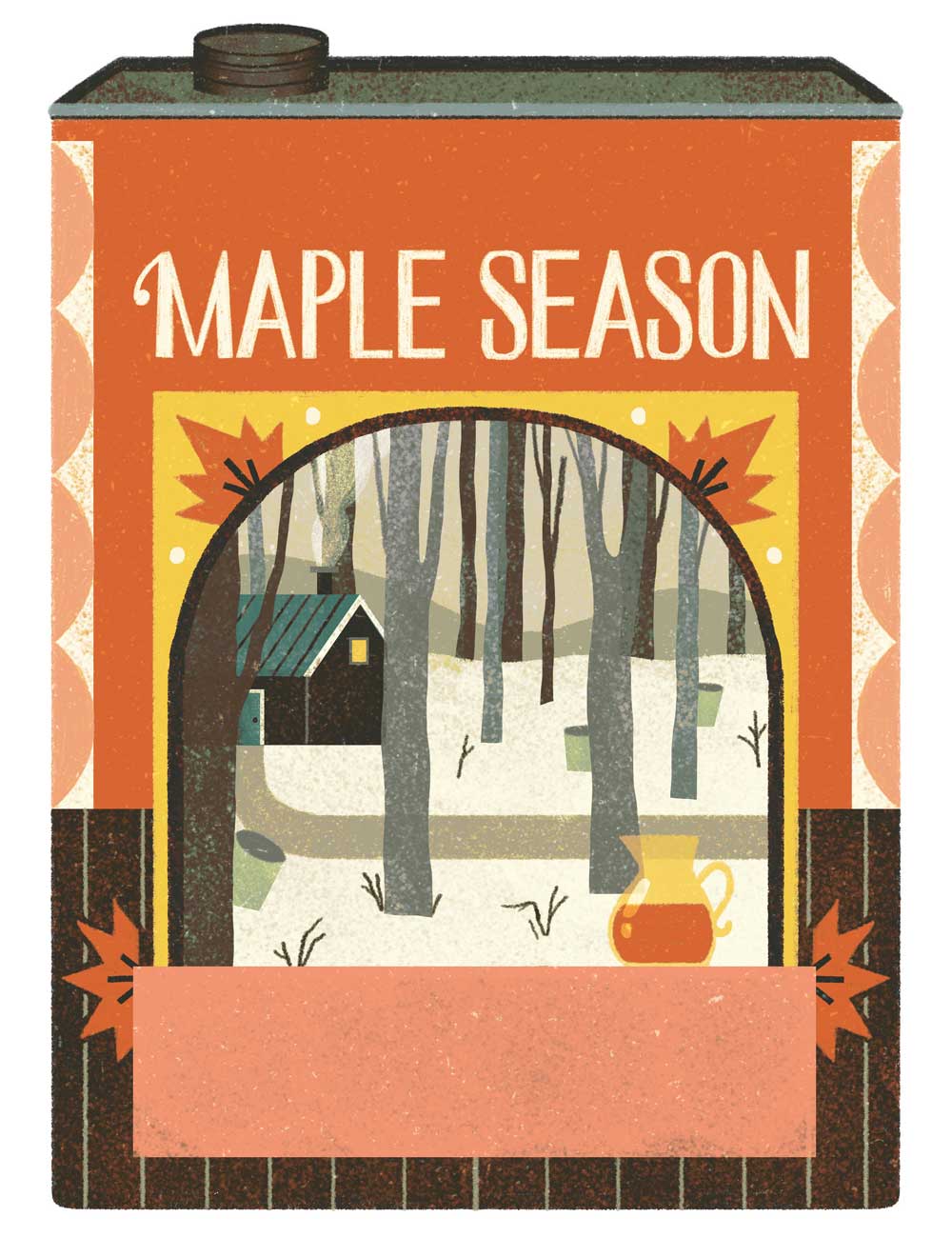
Coffee By Design | Portland, Maine
Photo Credit : Katherine Keenan8 Ways to Make the Most of Maple Season
1. Visit a Surfeit of Sugarhouses
I was sure we’d had our fill of maple. Then again, maybe not.
It was late morning on a Saturday in mid-March, and we were two-wheeling it up River Street, a winding dirt lane that dead-ends atop a hill in Poultney, Vermont, at a little sugar farm called Marshall Maples. It was Maple Open House Weekend, an annual event during which sugarhouses throughout the state are open to the public and small towns show off their maple bona fides. In Poultney, early risers had gathered at a church-hosted pancake breakfast, Governor Phil Scott had overseen a tree-tapping contest, and the town’s Maple Prince and Maple Princess had been crowned. The day would also include horse-drawn wagon rides, a sap bucket art exhibit, and a craft fair at the high school.
Only a few miles from downtown, a dozen of us were pedaling along both paved and dirt roads on a bike tour of local sugar shacks. “The goal is to get people on bikes but also integrate them with the outdoors and the local community,” explained the event’s 24-year-old organizer, Ryan Carr.
Although Carr is an intense cyclist—he doesn’t own a car, instead making his daily 20-mile commute year-round by bike—what he’d assembled today was a decidedly casual affair. Participants’ ages and bikes spanned the decades; newer mountain bikes rode alongside old cruisers, which coasted beside makeshift hybrids. At the front of the pack, bike shop owners James Johnson and Candice Passehl (whose Analog Cycles is actually housed in a converted sugarhouse) powered forward on a yellow tandem.
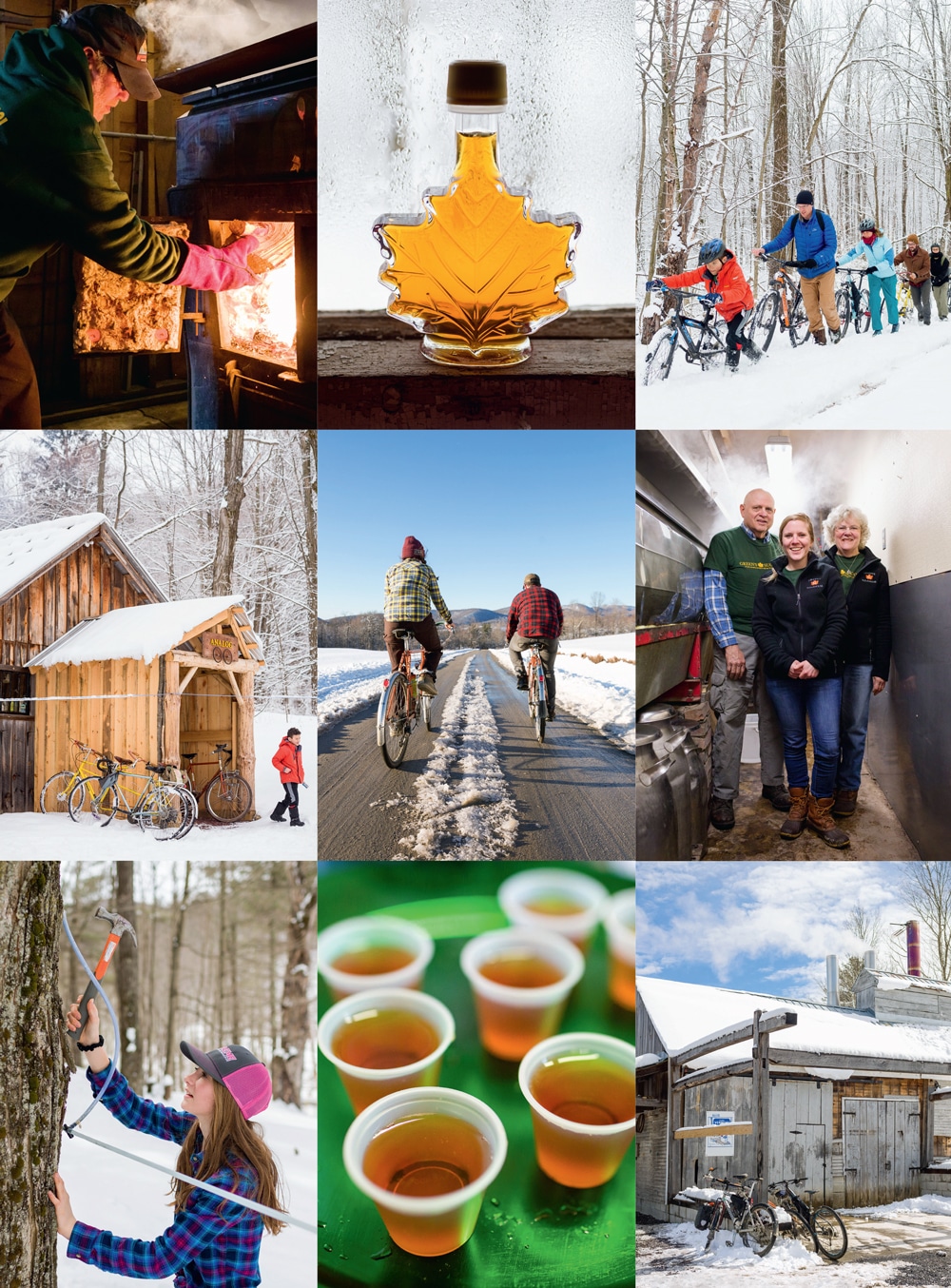
Photo Credit : Oliver Parini
The plan was simple: Bike, sample maple, and bike again. But this being early spring, and this being New England, the terrain didn’t always cooperate. On River Street, six inches of fresh snow from the night before had converged with thawing mud to create a heck of a slog. A quarter of the way up, a few riders hopped off their bikes to hoof it. My 8-year-old son, Calvin, followed. Then it was my turn.
“We ate too much maple!” Calvin reasoned, recalling the samples we’d scarfed at our previous stop. Rookie mistake.
But once inside the next sugarhouse, we again willingly held out our hands—this time for fried dough topped with cream—all the while admiring the big evaporator at work. Were there more hot goodies to try?
Of course, there are easier ways to tour a region’s sugarhouses. But being on a bike, even with layers of warm clothes on, felt like a rebuke to whatever remained of winter. Around us was an awakening landscape, as pastures and orchards reemerged. Back on River Street, we easily pedaled through the soup we’d recently struggled with, and at the bottom of the hill we looked as though we’d been in a mud fight. Yet I don’t think I’ve had a better two minutes on a bike in my life.
We were still looking mud-caked when we landed across town at Green’s Sugar House, where owner Richard Green greeted us at the door. “You guys biked all the way here?” asked Green, whose family has farmed in the area since 1774. “That’s impressive.”
Inside the sugarhouse and tasting room, maple mania was working up a full head of steam. A group from New York City took no notice of our muddy clothes as we gathered around the maple cotton candy or went for another try of the maple vinaigrette. After Calvin and I finished a wad of spun maple, I looked at him. “I think I’m done,” I said.
We still had a few miles left to ride back to our car, and there were no more sugarhouses left to visit. I really meant it this time. —Ian Aldrich
This year’s Poultney Maplefest Bike Tour will be held March 21. For more information, go to slatevalleytrails.org.
Maple’s March Madness | Guide to New England Maple Celebrations
New England maple celebrations abound in March, concentrated around statewide open houses. Check websites for participating shacks near you.
- Connecticut (3/21–3/22): Get a taste of the Nutmeg State’s small but scrappy maple industry at its first-ever open house weekend. ctmaple.org
- Maine (3/22): New England’s oldest statewide maple party showcases 80-plus locations. mainemapleproducers.com
- Massachusetts (3/21–3/22): Visit the website to find out which sugarhouse is hosting this year’s kickoff, where state officials will tap a ceremonial first tree. massmaple.org
- New Hampshire (3/21–3/22): More than 100 Granite State sugarhouses open their doors; the Canterbury Maple Festival and the Kearsage Maple Festival are also on tap this weekend. nhmapleproducers.com
- Vermont (3/21–3/22): The top maple-producing state welcomes some 40,000 visitors to 130-plus sugarhouses. vermontmaple.org
2. Get to Know a Local Maple Producer
April Lemay never set out to be a sugar maker. In fact, less than a decade ago the Vermont native was working in Boston as a partner at an international accounting firm. But then 813 acres of family land in Lemay’s hometown of Canaan went up for sale, including a large sugarbush; Lemay, who’d been looking for an investment opportunity, bought it. She erected a sugarhouse, set out 9,000 taps, began coming home on the weekends to help her parents boil sap—and April’s Maple was born. In 2014, Lemay returned full-time to the Northeast Kingdom to run her business, which had grown to include a café serving breakfast and lunch. “People kept saying it was such a brave move, but it never felt that way to me,” she says. “It just felt like the next opportunity.” We recently caught up with the 45-year-old Lemay during a morning shift in the café kitchen. —Ian Aldrich
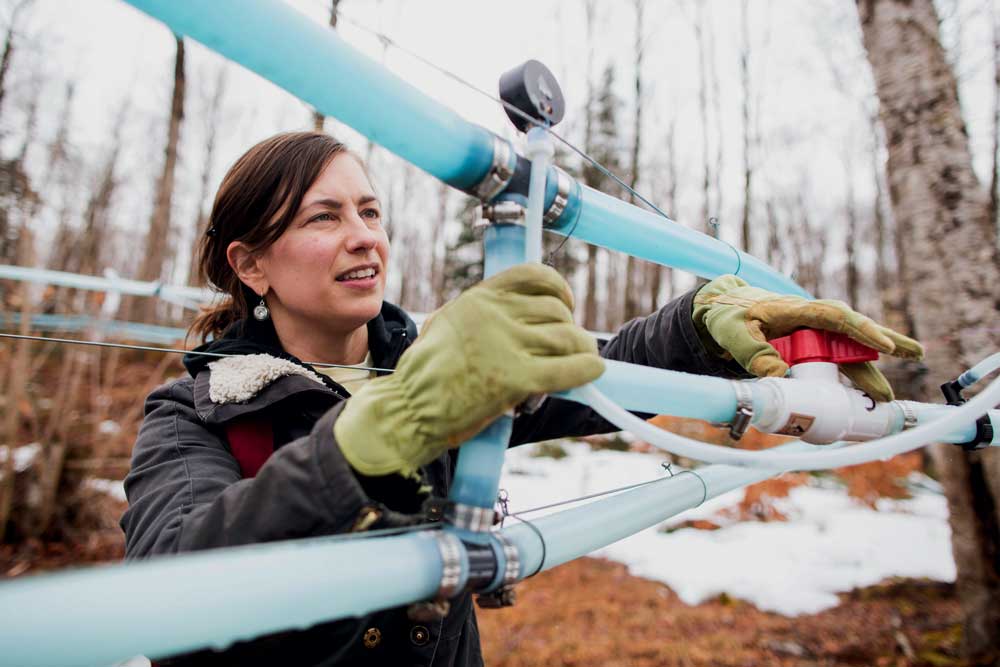
Photo Credit : Scott Eisen/Bloomberg via Getty Images
“My grandfather owned the land I have now, and he had carefully logged it to preserve the sugarbush. He had a small sugarhouse, and we’d head up there on Easter. He’d hang a ham over the evaporator. The steam would cook the ham, and the drippings would keep a check on the foam from the boiling sap. [Laughs.] Everybody got something out of it. There was ham and maple syrup, and we got to eat both!”
—
“For me, it was easy to come home. Many of the families I knew as a kid were still here. I didn’t have a problem reintegrating into the community. The things I miss are easy things, like a good Indian restaurant or good Thai food. But these are trivial things—they’re not essential to life.”
—
“I see my family all the time. I work with my husband. Both my parents still work for me, my Aunt Bonnie cooks in the kitchen, my Aunt Fran has her art on the walls, and my Aunt Hylie makes the bread I sell. There is no struggle to find a work-life balance like I had in the corporate world. It’s ingrained in everyday living.”
—
“I’m not afraid to answer my phone anymore. I don’t feel like I have to take a phone call in the middle of dinner. I’m not a doctor, I’m not saving lives up here. If your problem can’t wait until after dinner, I’ve done something wrong.”
—
“I love it when I know I’m going to work outside and spend a day in the sugarbush. The smells, what I’m seeing, working the land—it’s hard not to appreciate what I’m doing.”
—
“There’s this thing that maple represents to people. We’re working the land. That’s part of it, and it’s an easy thing to romanticize. But as sugarers, we’re also dealing with a product Mother Nature has basically already made. All we do is collect sap and remove the water to turn it into something that makes people feel good. I think people find that kind of thing magical.”
—
“I know I’m not what people expect. For starters, I’m a female and younger than what most people imagine a sugarer being like. … People sometimes come in here and see my parents and just think they own the place. No, there’s actually an April at April’s Maple. But the sugaring community is incredibly welcoming. If you’re new to the business they’ll talk to you about what they do. They probably won’t share their family secrets, but it’s not a community that shuts the door on other sugar makers.”
—
“I’m so lucky to be in such a happy business. People who come in here generally have a smile on their face. They’re not looking to fight about anything. … It’s a great place to be. As we say, have a sweet day. And we really do.”
6507 Route 114, Canaan, VT. 802-266-9624; aprilsmaple.com
Sticky Business | Year-Round New England Sugarhouses
Syrupy-sweet neighbors are a good thing … if you’re talking about New England sugarhouses that are open year-round. Below are a few of our tried-and-true favorites; for more options, check the websites of state maple producers.- Morse Farm Maple Sugarworks: You might be lucky enough to bump into seventh-generation maple sugar farmers Burr Morse on the job, but if not, look for his folksy memoirs in the gift shop. Do not leave without trying a maple creemee. Montpelier, VT. moresefarm.com
- Ben’s Sugar Shack: Just a bucket’s toss from Yankee’s offices (about a dozen miles) is this classic country shack founded by maple prodigy Ben Fisk, who was winning awards for his syrup when he eas a teenager. Temple, NH. benssugarshack.com
- North Hadley Sugar Shack: Launched in 1996 by Joe and Shelly Boisvert on family land, this sweet outpost now includes a farm stand, deli, and bakery. Look for its “sugarin’ breakfasts” during the holidays and in maple season. Hadley, MA. northhadleysugarshack.com
- Lamothe’s Sugar House: From just seven taps in the 1970s, the Lamothe family has built the state’s largest maple syrup producer. Yet theirs is still the kind of place where you can see three generations bustling to a fro, learn a little syrup-making lore, and meet a friendly golden retriever or two. Burlington, CT. lamothesugarhouse.com
3. Grab a Blue-Ribbon Bottle
While about 40 gallons of sap are needed to make a gallon of maple syrup, it takes a little something extra to make an award winner. Exactly what that something is, who can say—but try a maple syrup that’s brought home the gold, and you’ll get it.
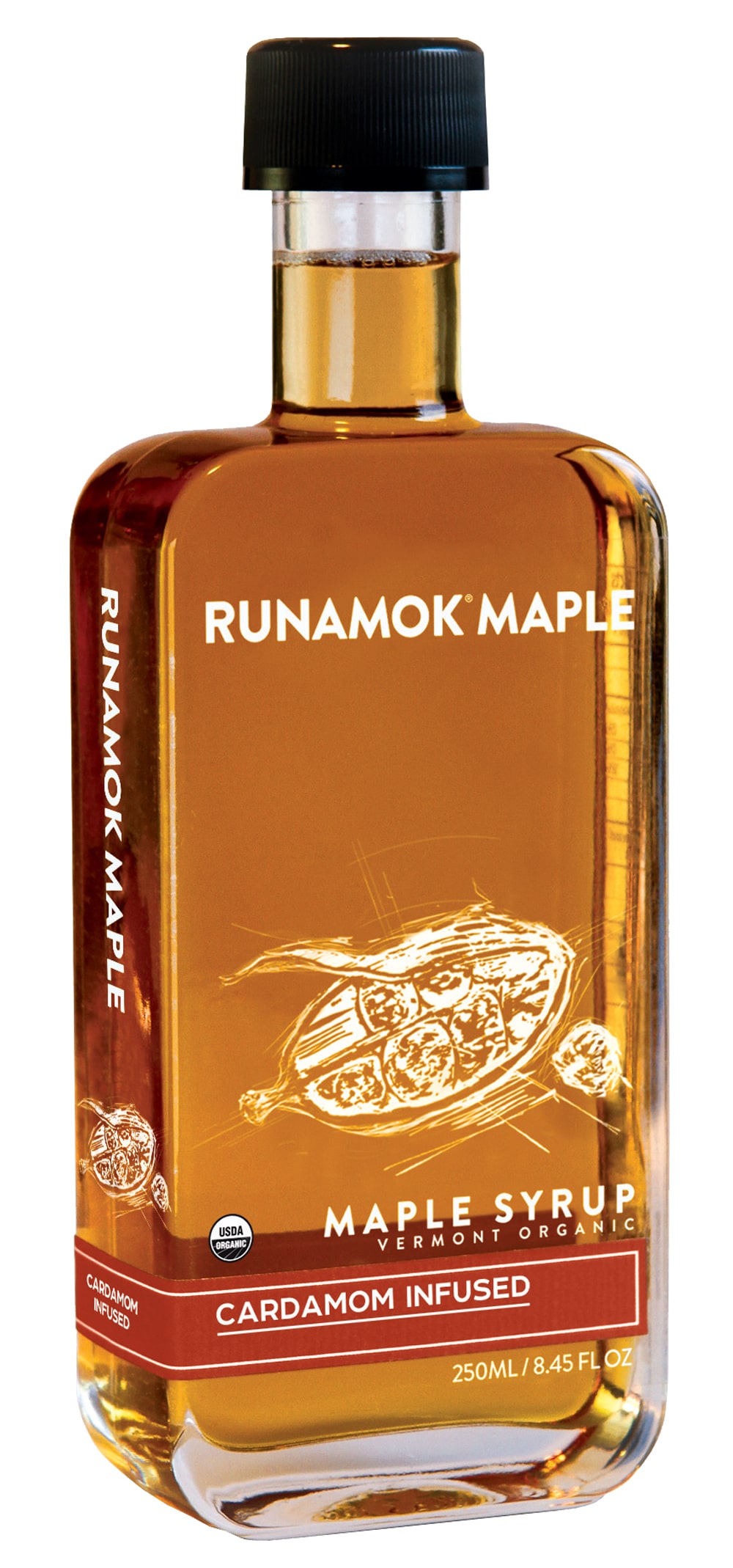
Photo Credit : Courtesy of Runamok Maple
Over the past decade, Vermont’s Runamok Maple has raked in the accolades for its elevated organic syrups, including a 2018 SOFI Award (aka “the Oscars of specialty foods”) for its ginger root–infused maple syrup, which bested more than 2,650 product entries in its category. Here at Yankee, it was Runamok’s cardamom-infused syrup that won over our taste buds and earned a 2018 Editors’ Choice Food Award. (Oh, and Oprah loves them, too.) Cambridge, VT. runamokmaple.com
Here are some other New England champs to look for:
- Fadden’s Sugar House: The seventh generation of Faddens claimed the New Hampshire Maple Producers Association’s trophy for the best maple syrup in the state last year—an award the family has already won seven times. North Woodstock, NH. nhmaplesyrup.com
- Girard’s Sugarhouse: The golden syrup crafted by Mike Girard, whose ancestors once sugared in Quebec, beat out an international field for a blue ribbon at the 2019 North American Maple Syrup Council competition. Heath, MA. Facebook
- Bragg Farm: This aptly named eighth-generation producer took 2019 Best in Show honors with its golden syrup at that venerable sugaring showdown in St. Albans, the Vermont Maple Festival. East Montpelier, VT. braggfarm.com
- Spring Break: Still a relative newcomer, Spring Break marked its 20th anniversary with three first-place syrup wins and a Best in Show at the 2018 Maple Mania contest—then notched two more blue ribbons the following year. Smyrna, ME. mainemapleandhoney.com
4. Pour it on at a Real-Deal Pancake House
Parker’s Maple Barn in Mason, New Hampshire, isn’t the kind of place you stumble across. One back road leads to another, then another, before this country campus of restaurant, store, and sugarhouse emerges from the woods just north of the Massachusetts border. You have to make it your destination.
There are easier-to-find places to get a flapjacks fix, but at Parker’s and other old-school pancake houses—including Polly’s in Sugar Hill and Intervale Farm in Henniker, both in New Hampshire—the allure isn’t just the meal. It’s immersing yourself in the sweetest kind of nostalgia.
Born from a homegrown sugaring operation, Parker’s opened in 1969 and was run by its namesake family until Ron and Sandy Roberts bought it in the ’80s; today, their son and his wife, Ron Jr. and Tanya, are the ones serving up the memories. The property spreads across 19 acres and includes the Corn Crib, a gift shop with old-timey candies and maple gift baskets; a sugarhouse and wood-fired evaporator that cranks away tirelessly during maple season; and even a replica covered bridge.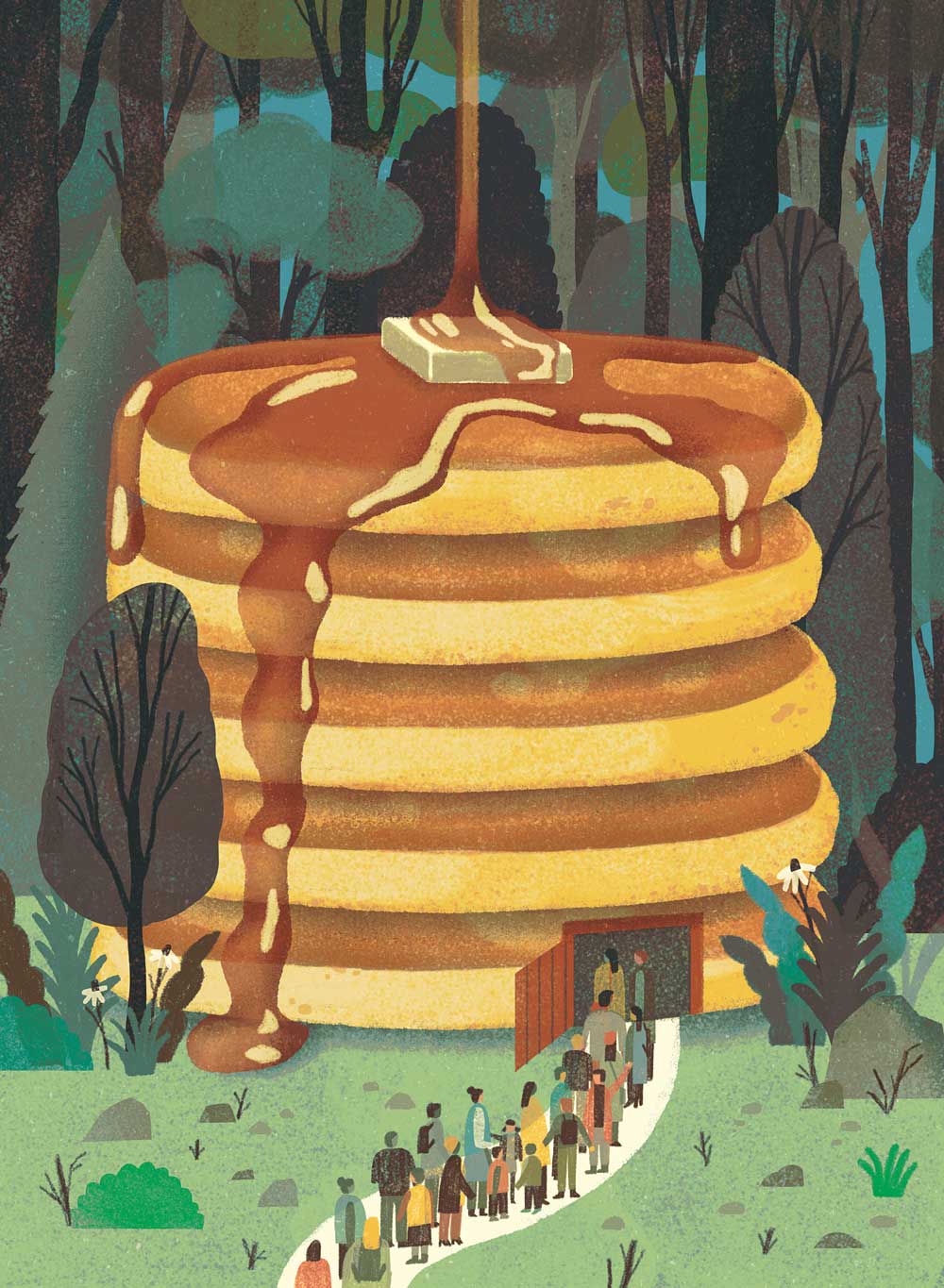
Photo Credit : Wenjia Tang
Amid all this Instagrammable quaintness is the restaurant itself, where big beams and a pair of stoves keep the old building feeling cozy. The decor runs to handmade tables and farm antiques; the food, meanwhile, borders on the overwhelming. You can indulge in sugary pastries both baked and deep-fried (doughnut holes, cinnamon buns) and choose dishes and sides that celebrate the season (maple ribs, maple baked beans). Naturally, there are all kinds of pancakes and waffles for sopping up the house-made syrup. And did we mention the justifiable-at-any-hour maple frappe?
Despite its tucked-away location, Parker’s is no local secret—and on weekends in March, when maple season is at its peak, more than a thousand eager customers stream into the restaurant. Time your visit wrong, and the wait for a table could be a good two hours. But ask the regulars, and they’ll tell you: It’s worth it. —Ian Aldrich
1316 Brookline Road, Mason, NH. 603-878-2308; parkersmaplebarn.com
5. Ski Through the Sugarbush
John Ripley wants to show us how maple trees heal. We are bounding along on cross-country skis at Maple Corner Farm in Granville, Massachusetts, touring a sugarbush of hundreds of acres of mature maple trees. John, whose family has been farming these woods and fields since 1812, moves as if he had been born on skis, and no wonder: The farm opened a skiing center 36 years ago, when he was just a boy, to diversify its operations in winter.
We pull up to look at a four-foot cross-section of a recently felled maple. Midway through its annual rings was evidence: a small dark scab the size of a coffee bean, a pock on otherwise perfectly concentric circles. This grown-over spot is where the tree healed after being tapped about 30 years ago, says John. “We use only the most compassionate, least invasive taps,” he explains. “It’s a light compression system, to help everything flow downhill.”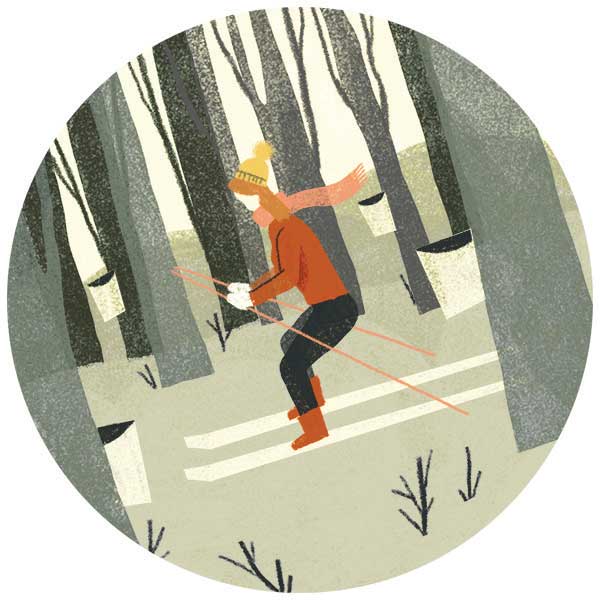
Photo Credit : Wenjia Tang
To ski through the Ripleys’ sugarbush is to follow the path of the sweet stuff, to race the sap to the bottom of the hill. Aptly named trails like Old Sugar House and Bucket Path traverse a forest of maple trees of every age, from spindly teenagers reaching for the sun to wide-bottomed elders, some 200 years old, that anchor whole slopes. Brookside Trail meanders alongside a burbling stream, and we come upon a beech tree with an apron of fresh woodchips around its base, a woodpecker’s morning shift. John shows us an offshoot trail that leads to a sparkling half-frozen waterfall, fed by the nearby Cobble Mountain Reservoir.
Sap pipeline and some 4,500 taps connect the trees, just as relics stitch together the Ripley family history. We come upon a foundation wall where John’s great-great-grandfather sugared using an iron kettle and a flat pan, which visitors can see and touch for themselves in one corner of the sugar barn. There’s also a photo of John’s dad, Leon, as a little boy in 1956, helping boil the sap with his father.
The Ripleys curate their past and at the same time are bent on the future. Parents Leon and Joyce run the farm while all three grown sons and their families help out, including operating a sugarhouse built in 2018 and outfitted with gleaming high-tech equipment and touchscreen controls. When the sap is flowing, they can collect up to 5,000 gallons a day, 70,000 gallons in a season. From grandparents to grandkids, all hands are on deck to process that into maple candies, creams, and sugars; to rent skis and snowshoes; and, on weekends during sugaring season, to make and serve a sweet breakfast for hungry skiers and nonskiers alike. —Carole Connare
794 Beech Hill Road, Granville, MA. 413-357-8829; maplecornerfarm.com
6. Drink In All That Mapley Goodness
I appreciate a good grade A amber as much as the next guy, but in truth, I rarely partake. Born without a morning sweet tooth, I tend to evaluate a brunch menu mostly by counting the number of not-pancakes. I’m not saying the 12.7-ouncer of organic maple syrup in my fridge door doesn’t have a figgy nose and a gentle, buoyant viscosity that belies the butterscotch intensity of its finish. I’m just saying it might be a lifetime supply.
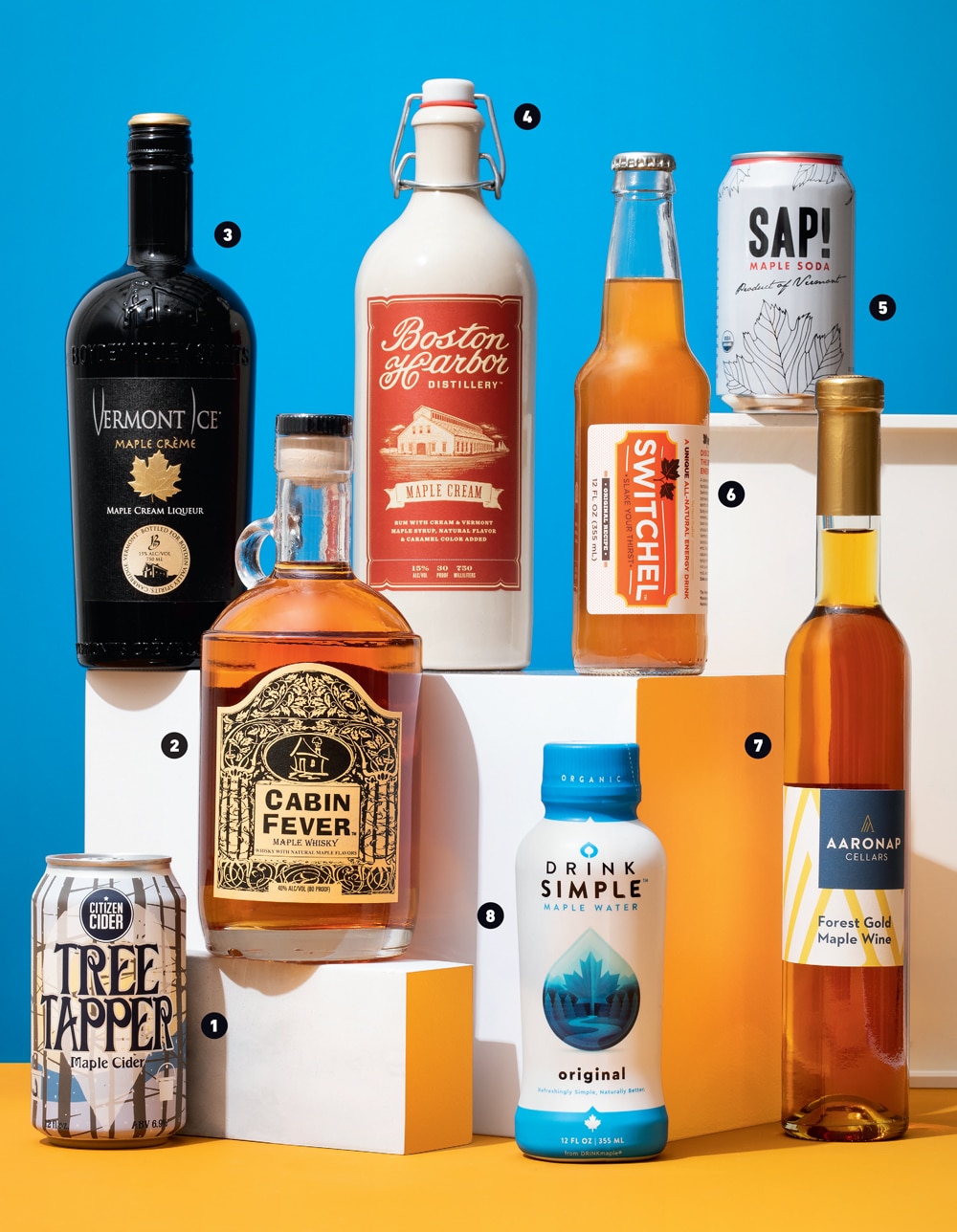
Photo Credit : Adam Detour
Leave it to savvy marketers to find ways to coax French-toast agnostics like me into the liquid-gold fold. Emboldened by a rising interest in naturally sweetened beverages, the maple syrup industry is giving coconut water a run for its money, developing tree-tapped variants to wet the whistles of the discerning watering-hole crowd. To separate the sippable sap from the worthless, well, stuff, I gathered a sampling of New England libations to see what they were made of. —Jolyon Helterman
1. Tree Tapper Maple Cider (4 stars) Citizen Cider, Burlington, VT
Do you taste it? I taste it! I mean, I think I taste something vaguely mapley, when I press my tongue into the roof of my mouth, exhale through my nose, and stand in the parking lot of a busy pancake house. Jokes aside, Citizen makes an impressive line of hard ciders, and this variant sweetened with syrup from Runamok Maple is no exception—though you may be hard-pressed to guess its tree-tapped provenance from taste alone. citizencider.com
2. Maple Whiskey (2 stars) Cabin Fever, Chester, NH
Aged for three years in a non-charred barrel, then infused with grade B Vermont dark maple syrup, this flavored Canadian whiskey probably has too much burnt sugar, vanilla, and butterscotch on the nose and the finish for serious whiskey fans. But it’s probably just what the doctor ordered for a hot toddy or high-octane eggnog. cabinfeverspirits.com
3. Vermont Ice Maple Créme (4 stars) Boyden Valley Winery & Spirits, Cambridge, VT
This balanced mix of French oak–aged apple ice cider, apple brandy, fresh cream, and organic maple syrup made on-premises is a cut above other cream liqueurs I’ve tried, with enough layers of complexity to serve neat or chilled. Or poured over vanilla ice cream. Or coffee ice cream. Or, like, a banana split–style sundae with both flavors, and … and, anyway. You get the gist. boydenvalley.com
4. Maple Cream Liqueur (3 stars) Boston Harbor Distillery, Boston, MA
Rum cream, the Caribbean answer to Baileys, typically gets its sugary richness from sweetened condensed milk. This New England spin instead leaves the dessert-ing to Vermont syrup, blending it with rum-spiked Wisconsin cream at just the right strength to transform a hot mug of coffee into an après-ski (or après-breakfast) pick-me-up. For a straight-up sipper, though, the flavor profile is a tad too two-dimensional. bostonharbordistillery.com
5. Maple Soda (2.5 stars) Sap!, Middlebury, VT
Cream soda isn’t for everyone, and your opinion of the genre is probably an accurate predictor of how much you’ll like this maple-flavored soft drink. For fans—or for parents of fans—this naturally sweetened beverage (80 calories per can) forges a path of moderation between full-sugar A&W (170 calories) and the aspartame-bolstered scaries of the “diet” stuff. sapvt.com
6. Switchel (4.5 stars) Vermont Switchel Co., Cabot, VT
The original switchel—diluted apple cider vinegar sweetened with maple syrup—was the energy drink of choice for discerning 19th-century New England hay farmers, and this mostly organic rendition has such a lively mix of acid, sweet-tart fruit and tongue-wicking astringency that it drinks like a wine. Specifically, a wine that drinks like a mulled Arnold Palmer finished with figgy lemon prune juice, melted apple Jolly Ranchers, and that “Russian tea” thing people used to make in the ’70s with Lipton, cloves, and powdered Tang. Refreshing stuff. vtswitchel.com
7. Forest Gold Maple Wine (5 stars) Aaronap Cellars, Westford, MA
Imagine a cartoon chase sequence involving, I dunno, Bugs Bunny frantically feeding pineapple upside-down cakes into the hopper end of a lurching contraption that, for whatever reason, distills all that butter-caramel-edged, dry-heat-burnished tropical-fruit intensity and juiciness into something way more delicate: perchance, a bead of clove-kissed nectar daubed from a honeysuckle’s swollen stigma (but you know, enough for a 375 mL bottle). Wine maker Noel Powell coaxes as much nuance from Berkshire maples as some zillion-dollar French dessert wines get from pedigreed late-harvest grapes, and the result is especially good with aged cheddar. aaronapcellars.com
8. Maple Water (1 star) Drink Simple, St. Alban’s, VT
Maple water reputedly has more manganese per serving than a cup of kale, and after trying the stuff, I can’t think of a single reason to doubt it. Barely sweetened, it has about half the sugar of coconut water—in theory a perk, but in practice this robs maple water of the silky mouthfeel that makes its archrival so hangover-morning-gentle. It’s the oaky chardonnay of bottled water, so if that sounds like your jam, give it a whirl. drinksimple.com
See More: Our Favorite Maple Products (That Aren’t Syrup)
7. Step Back in Time
At Old Sturbridge Village in Massachusetts, spring is ushered in not only by the first tree buds and bird songs but also by the enticing smell of woodsmoke. That’s because March brings the return of Maple Days, when this living history museum adds a maple sugar camp to its hamlet of 40-plus antique structures that conjure up New England in the 1830s.
Early European settlers in New England were introduced to maple sugaring by the region’s indigenous people, who sliced notches into maple trees to release the sap, which they collected in bark containers and concentrated either by freezing the sap and skimming off the ice or by heating the sap to evaporate the water.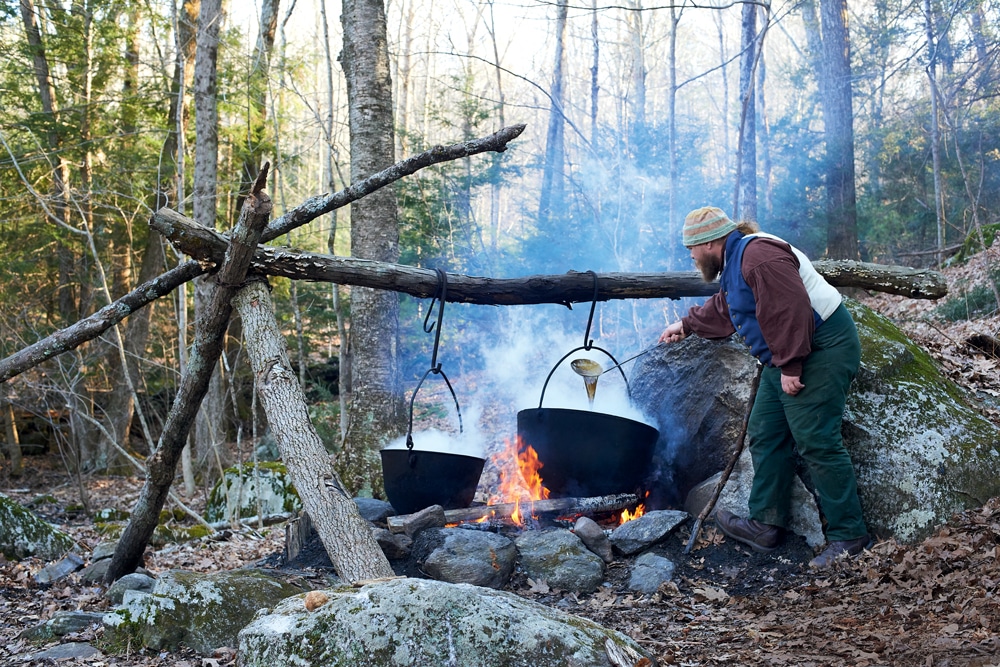
Photo Credit : Hornick/Rivlin
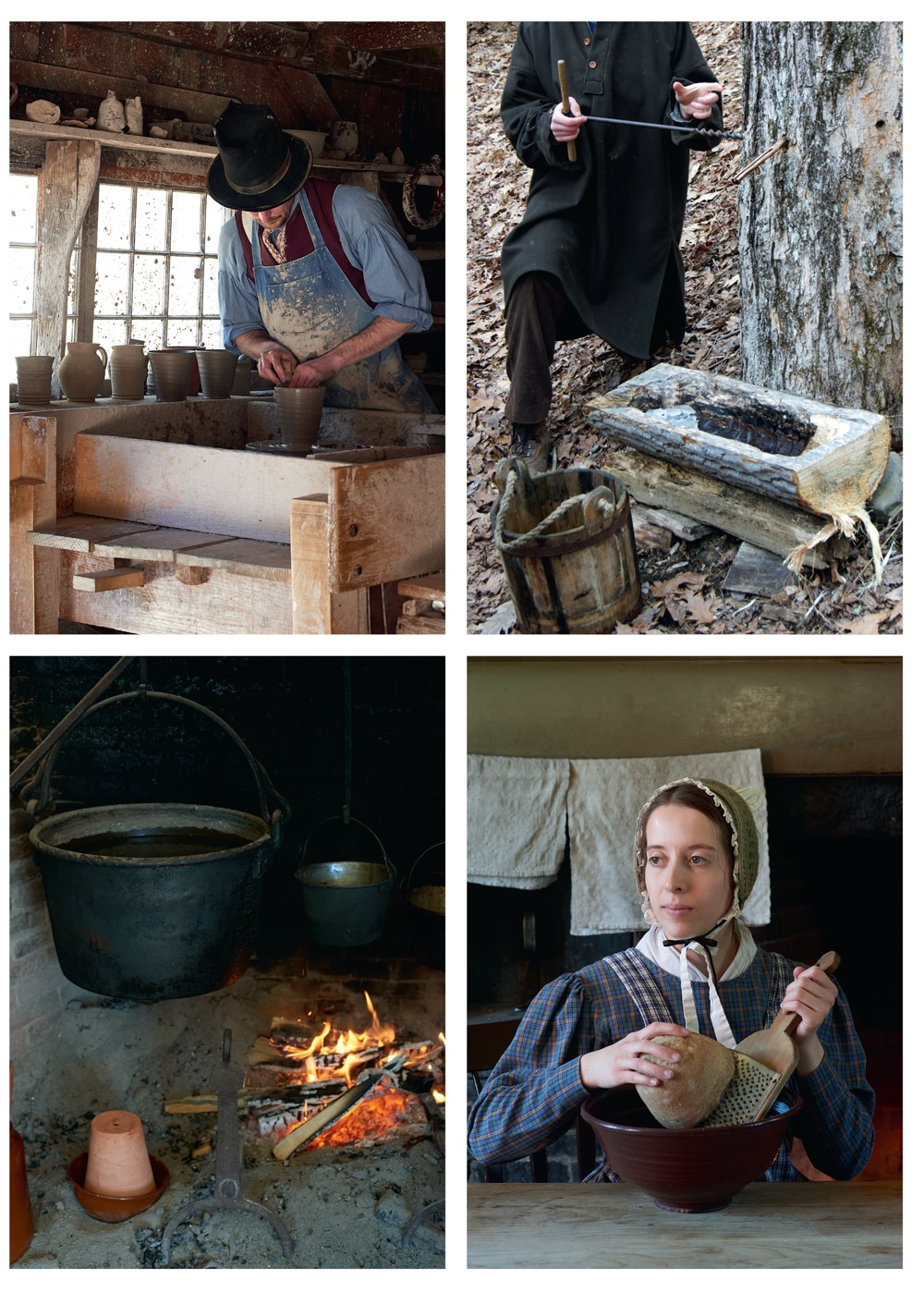
Photo Credit : Hornick/Rivlin | Courtesy of Old Sturbridge Village (tree tapping)
At Maple Days, reenactors demonstrate a slightly more evolved process that was practiced at early American sugar camps: Drill holes into the trees at a slight downward angle, insert wooden taps, collect the sap in a hollowed-out log or wooden bucket, and boil it down.
It’s a fascinating process for visitors to watch, but not a speedy one. The first boil happens on-site at the sugar camp, where it takes more than 24 hours of boiling to reduce 20 gallons of sap to roughly two gallons. This is then toted indoors for “sugaring off,” a closely watched final cook that can yield either maple syrup (sap reduced to about 1/35th of its original volume) or maple sugar (all liquid has evaporated).
Historic note: Although cane sugar was the dominant sweetener by the 1830s, many advocated for a return to maple as an alternative to this slave-produced import. —Joe Bills
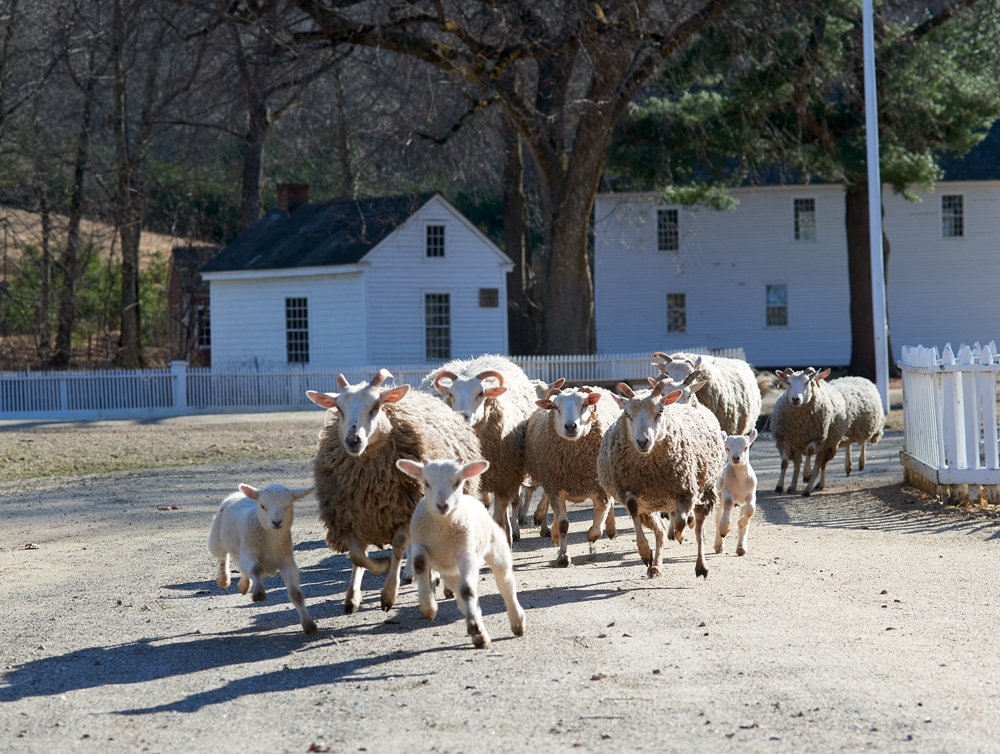
Photo Credit : Hornick/Rivlin
History on Tap
- Old Sturbridge Village: From tapping trees to “sugaring off,” Maple Days shows how maple syrup was made in rural 19th-century America at New England’s largest living history museum. Weekends in March. Sturbridge, MA. osv.org
- Institute for American Indian Studies: Discover how Native Americans processed sap with stone and wooden tools, learn maple syrup’s role in their culture, and sit down to a pancake breakfast with fellow history buffs. 3/14. Washington, CT. iaismuseum.org
- Remick Country Doctor Farm & Museum: The demonstrations at this rural farmstead span the centuries, from Abenaki sap boiling techniques to a modern evaporator. 3/21–3/22 (outdoor demos Saturday only). Tamworth, NH. remickmuseum.org
8. Make a Sweet Excursion to Quebec
In early April in the more northerly latitudes, you have to look up to find spring. Start at three feet, the recommended height for a maple tree tap. The sap has been flowing for a few weeks now, mostly into vacuum tubing—but buckets still dot the trees here and there, and these markers are among the happiest harbingers of spring. Now look up, way up, and notice how the sun lingers above the horizon well into the dinner hour and makes all good things feel possible one again.
This is the golden light I’m soaking up as I make my way through the still-snowy forests of Rigaud, Quebec, a hilly semirural district near the Ontario border. I’ve driven nearly six hours from Boston, lured by a knowledge that both delights and confounds: For all our pride in New England’s maple culture, with its maple candy, sugarhouse tours, and pancake breakfasts, Quebec has an exponentially more vibrant one. Not only does our northern neighbor produce more syrup (72 percent of the world’s supply), it has a true maple scene, one centered on sugar shacks called cabanes a sucre, where people gather for elaborate meals that typically feature live music, generous pours of wine, and equal parts merriment and relief at having survived another winter.
Cabanes a sucre range from tiny family-run shacks, places with just a door separating the dining room from the evaporator, and upscale destinations such as Montreal celebrity chef Martin Picard’s twin eateries in St-Benoît-de-Mirabel (plan early, as reservations open December 1 and sell out in a few days). Everywhere, though, the aesthetic is reliably cabin-chic, rooted in Quebecois vernacular. People eat at large communal tables, ceilings are beamed, stone fireplaces roar, fiddles loop and twang.
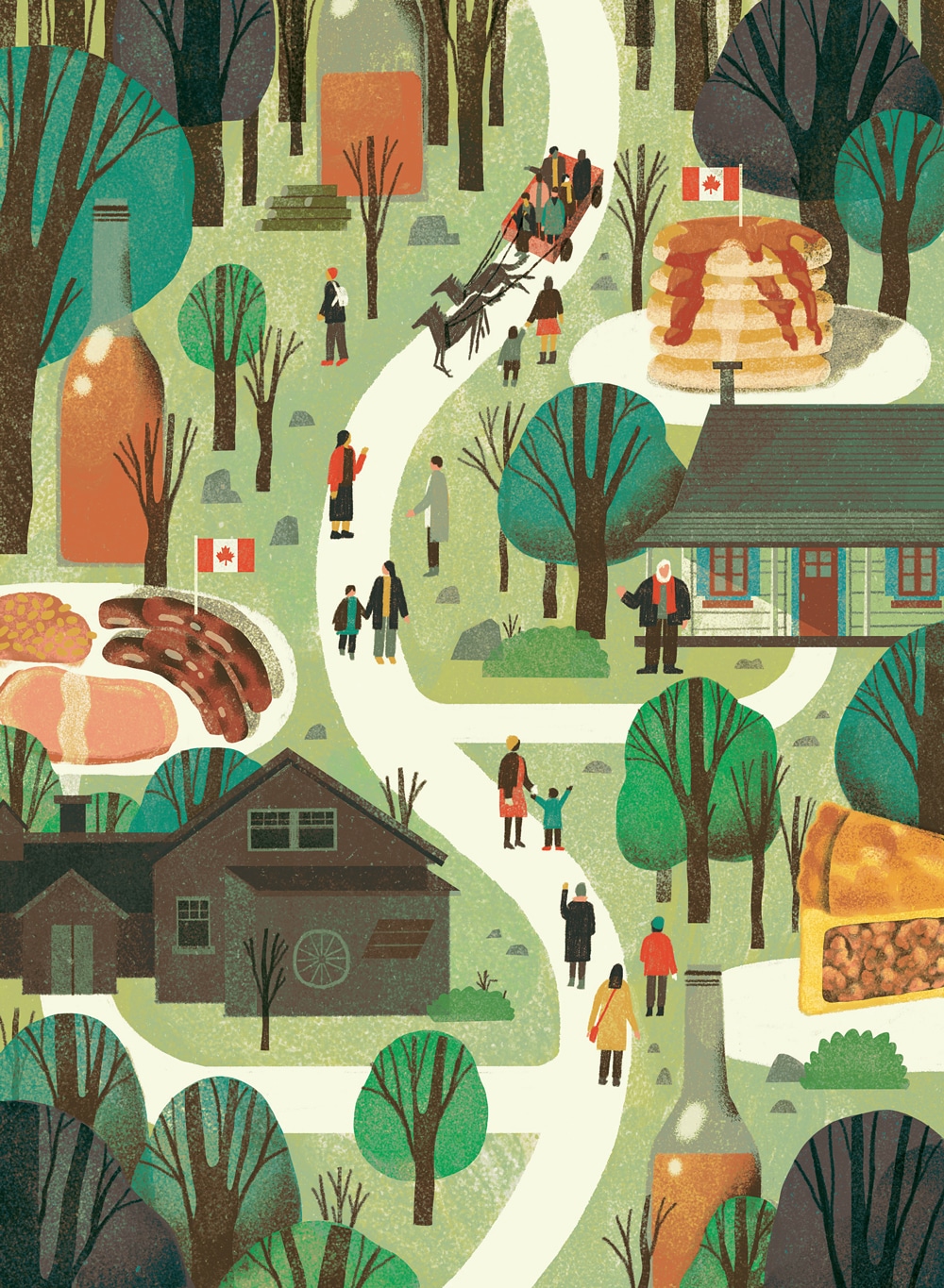
Photo Credit : Wenjia Tang
At Sucrerie de la Montagne, a woodland complex of traditional Quebecois log cabins about 50 minutes west of Montreal, the vibe is part country food hall, part living history museum, with a central wood-fired bakery, sugarhouse, general store, and log cabins for overnight stays. Owner Pierre Faucher and his son, Stefan, are warm and jovial ambassadors of traditional French-Canadian culture. With his white beard and stout middle, Pierre could find side work as a department store Santa, but there’s no need: The sucrerie hosts a steady stream of tourists, young Montrealers, school groups, and families all year round. “I do this to keep the tradition alive,” he says. “The industrial way of producing syrup is drowning our traditions. This is springtime as my people used to do.”
Here, a horse-drawn sleigh takes you and your fellow visitors from the parking lot to a central green, where you linger around a roaring outdoor fire before heading into one of several food halls. The menu here, as in all cabanes, relies on the staple foods of late winter: pork, beans, flour, and lots and lots of syrup. It’s the kind of fare that farmers would serve their workers during sugar season, and while offerings vary slightly from place to place, the meal always begins with smoky pea soup and bread, assorted pickles, pork rinds, and a rustic pork pâté called cretons. There’s a baked omelet, as well as maple baked beans and mashed potatoes. Then there are the meats: ham, sausage, bacon, and the French-Canadian pork pie called a tourtière. You can pour maple syrup over anything and everything except the clove-scented meatballs, which come with their own gravy. If you are still sentient, finish with some combination of maple sugar pie, pancakes, maple dumplings, pouding chômeurs (a maple upside-down cake), and sugar-on-snow, a maple taffy that’s made and served outside.
Then go back to your little cabin and stoke the fire, which is the only source of heat but well able to ward off the chill. In the morning, you’ll wake to the smell of woodsmoke and bacon cooking, and know that something wonderful is waiting for you just around the corner. —Amy Traverso
Cabane Fever
- Sucrerie de la Montagne: Part sugar shack, part living history museum (think Old Sturbridge Village with tourtière and pancakes), this is the immersive cabane a sucre experience. sucreriedelamontagne.com
- Cabane du Pic Bois: Run by the Cardin-Pollender family for four generations, this little shack has a more intimate feel. Be sure to pick up a bottle of their signature maple vinegar. cabanedupicbois.com/en
- Érablière Hilltop: A midsize operation just 15 minutes from the Vermont border, this shack offers sweeping views and terrific maple dumplings. erablierehilltop.com








What a thoroughly enjoyable article this was! Great work with the interviews. Thank you.